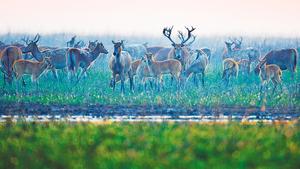Reintroduced to China in 1986, the deer now thrives in its native land
 A herd of wild milu deer roam the Dafeng Milu Deer National Nature Reserve in Jiangsu province. (WANG YAZHOU / FOR CHINA DAILY)
A herd of wild milu deer roam the Dafeng Milu Deer National Nature Reserve in Jiangsu province. (WANG YAZHOU / FOR CHINA DAILY)
Once extinct in China, its native land, and with only 18 individuals surviving in the world, the milu deer is now prospering in its home country.
A total of 5,016 animals were recorded at the Dafeng Milu Deer National Nature Reserve in Yancheng, Jiangsu province, in May last year, accounting for 60 percent of the species’ global population.
The number of deer in the reserve has grown remarkably, considering they are the descendants of just 39 milu reintroduced to Dafeng in 1986 as a gift from the British government.
Just over one-fourth of the milu, also known as Pere David’s deer, wander in a wilderness area of some 1,000 hectares, with most of the rest living semi-wild in the other 1,667 hectares of the reserve and still being fed by reserve workers during the harsh winters.
As a result of an experimental project launched in 2017, another 78 young deer are captive and completely cared for by keepers.
After graduating from college, Yu Xiaopeng started working as a technician on the reserve’s research team in August 2016. In April 2017, he began raising milu at the reserve’s breeding center.
The reserve hopes to build up a captive population in its experimental zone, a park with an area of 722 hectares that tourists can visit.
To make sure the deer are not afraid of people, Yu and his colleagues try to catch them as soon as possible after their semi-wild mothers give birth.
In late March and early April, the season when milu doe usually give birth, Yu and three colleagues keep a close eye on pregnant milu in the park and, before the sun sets, try to locate those preparing to give birth.
“Before the sun rises, the newborns are usually still too weak to run and often lie on the ground,” Yu, 26, said. A newborn milu weighs around 12 kilograms.
During the breeding season, females from the semi-wild population give birth to 600 to 700 fawns. Yu and his colleagues catch 20 to 30 newborn deer for captive research.
After catching the fawns they immediately disinfect them, measure them to gather basic data and tag their ears.
The keepers then help the baby deer survive the three months until they are weaned. “The first 15 to 20 days are the most critical for them,” Yu said. “So they’re the busiest days of the year for us too, as we help them get used to milk.”
Because they are sensitive to undigested lactose, he said newborn deer were prone to diarrhea. Without any medicines to relieve the symptoms in 2017, many had diarrhea and some died. “We lost six baby deer in 2017, five in 2018 and four last year, from various diseases including diarrhea,” Yu said.
Last year they pasteurized milk and warmed it to 37 to 38 C before feeding the deer. Meanwhile, some medicines and nutrients were added to the milk.
As a result, Yu said, diarrhea was exceedingly rare and all the newborn deer survived their first two weeks in captivity.
About three weeks later, forage is gradually added to their diet, eventually replacing milk.
After three months, and already weighing 50 kg, they can finally meet visitors. At present, the captive young deer are kept in three enclosures in the park, Yu said.
The hard work paid off for Yu, who has published a paper on the prevention and treatment of four diseases common to milu.
Milu are also known as sibu-xiang, which translates as “four ways of being unalike”, because they are said to have a horse’s face, a cow’s hoofs, a stag’s antlers and a donkey’s tail.
Their hoofs can be a weapon, Yu said.
“Don’t let them step on your feet,” he said. “It can be very painful. Also we wear gloves while feeding them milk, to guard against their bites.”


